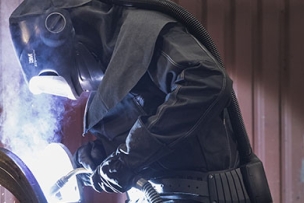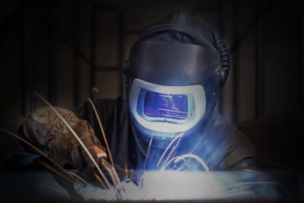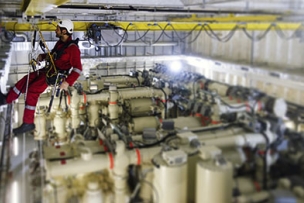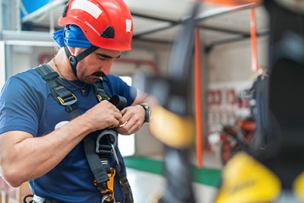Products that work as hard as you do. From the most basic to the most specialized needs, 3M offers the health and safety protection you and your workers need most, so everyone can perform at their best. We strive to deliver comfortable, well-designed personal protective equipment (PPE) that offers your workers the most effective protection available.
Mobile elevating work platforms (MEWPs), also known as aerial work platforms, scissor lifts, boom lifts, etc., are useful industrial devices to position workers, tools and materials. Their widespread use and popularity are evident across many industries.
At a minimum, MEWPs consist of a work platform with controls, an extending structure and a chassis.1 With advancements in technology and an increasing variety of equipment options, this type of equipment has become more common for those working at heights. Generally, MEWPs can offer a quicker, less costly and yes, at times, safer way to work when compared with traditional means (e.g., scaffolds and other temporary work platforms). And it is safer to work from a wide, flat, level surface, surrounded by guardrails, than using a ladder or climbing structures/equipment to gain access for work.
However, the proliferation of MEWPs has also contributed, in part, to the staggering numbers of fatalities and lost-time claims due to falls in Canada. According to the Association of Workers’ Compensation Boards of Canada (AWCBC), from 2015 to 2017 there were nearly 50,000 lost-time claims due to falls, plus 63 fatalities due to falls in Canadian workplaces.2 To be clear, only a modest portion of these numbers can likely be attributed to fall events that occurred while using a mobile elevating work platform. The availability of such industry data is limited.
Nevertheless, the use, or more accurately, misuse of fall protection equipment is a common cause of many of these fall-related tragedies, and falls involving mobile elevating work platforms are no different. The hazards related to fall protection and MEWPs are often underestimated and misunderstood.
Fall hazards
Most MEWPs also have built-in guardrail systems, so fall protection is taken care of, right? Wrong.
In some Canadian jurisdictions, fall protection by guardrail only is an acceptable practice in a specific set of circumstances, for example, if its use complies with all three of the following conditions: the device being used is a scissor lift, operating on a firm, substantially level surface and fall protection by guardrail only is permitted by the MEWP manufacturer.
However, baseline legal compliance is merely a starting point. MEWPs are different from scaffolds and other work platforms; the major difference is that they are mobile. To truly help protect people from harm, personal fall protection is strongly recommended when using this equipment.
Falling over guardrails is the cause of many injuries with mobile elevating work platforms. Typically, falling over MEWP guardrails is caused by workers reaching out beyond the guardrail system because the MEWP cannot adequately reach the required work location, or the guardrail itself inhibits the work in some way. The fundamental cause is poor planning, and this leads some workers to inappropriately extend their vertical reach by standing on mid rails, or even stand and balance themselves on top rails. They may also try to extend their reach horizontally over top rails or in between top rails and mid rails.
Falling while entering or exiting a mobile elevating work platform is also a concern. In some instances, workers use MEWPs solely for access. Work may need to be performed on a roof, mezzanine or other platform with limited access, therefore requiring workers to transition from a MEWP onto another platform. Fatal falls can occur if the worker does not use a personal fall arrest system (PFAS) and maintain 100% tie-off, or if the MEWP:
• does not have a well-designed gate for ease of access/egress, or
• is not situated in close proximity to the landing surface.
Tip-over and ejection is another serious hazard. Generally speaking, a mobile elevating work platform can become unstable if not operated on a firm, flat, level surface capable of withstanding all load forces imposed by the MEWP in all operating conditions.3 Any of the following circumstances can also lead to potential instability:
• exceeding the platform capacity;
• disregarding warning alarms and signals;
• using excessive manual force;
• hoisting materials with the MEWP;
• using the MEWP as a jack;
• altering, disabling or overriding safety features/devices (e.g., tilt alarm, limit switches);
• failing to deploy stability enhancing devices, if the MEWP is so equipped (e.g., outriggers, stabilizers);
• collisions with other vehicles, objects or structures;
• inadequate maintenance; or
• high wind speeds.
Tip-overs are extremely dangerous not only to occupants of the mobile elevating work platform, but also to other people in the vicinity. Ejection of an occupant, whether connected to an approved anchorage point with a PFAS or not, can be fatal or cause severe injuries. Although it is a matter of some contention, regulators and manufacturers generally deem it is safer to remain within the MEWP guardrail system than be launched into the air. In other words, the occupants should remain as occupants at all times during operation.









Talk to Us!
Leave a reply
Your email address will not be published. Required fields are marked *